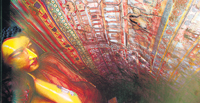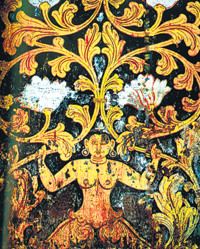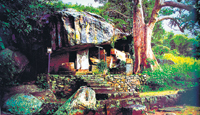|
|
|||||||||||||
|
Kandyan grandeur A picturesque journey through temple murals
Jeevan Naide from Nilagama was the last link in a sittara paramparawa – a dynasty of traditional temple artists of the Kandyan period. Until his death a few years back, he maintained the priceless paintings of the Dambulla rock temple. Though he had two sons, they have not followed in his footsteps to learn this art which had been handed down from generation to generation.
"In sharing his deep knowledge of temple art, he inspired in me a life-long fascination for the artistic heritage of our temples," says renowned photographer of temple paintings, Gamini Jayasinghe dedicating his latest publication, Sri Lankan Buddhist Art: Post-Classical Revival, to Jeevan Naide.
This beautifully illustrated publication on the exquisite collection of paintings from the “Kandyan School” will be launched on July 21, at the BMICH.
The restoration work by the Nilagama family has been recorded in detail under Nilagama Tudapata, a palm leaf manuscript where the skill of Jeevan Naide in making colours from vegetable dyes used by his ancestors is dealt with. The Kandyan classical school of painting began to decline after the 14th century due to the unstable state of the country, with kings moving from place to place. However, a provincial style of painting with features of folk art emerged, practised by sittara artists who decorated the walls of temples. According to Jayasinghe, the style of painting figures adopted by the artists conveyed the message in the form of a narration to the devotee, who responded with religious zeal.
A new generation of painters emerged under the patronage of King Kirti Sri Rajasinghe (1747-81 A.D), who not only built many image houses in and around Kandy but also in the remote areas of his kingdom. The provincial chieftains followed the king's example. Jayasinghe identifies Lankatilaka, Degaldoruwa, Medawala, Suriyagoda, Gangarama and Bambaragala as the best examples of shrines built during the Kandyan kingdom. Further away were the shrines at Dambulla, Ridi Vihara and Kelaniya. Many of the paintings in these shrines were by the masters of Dewaragampola and Nilagama. Jayasinghe has gone to great lengths to photograph these murals, with the temple visits being sponsored by Sampath Bank. The reader not only gets a look at the grandeur of these murals but also a clear picture of the ground plan of each temple through sketches indicating where the murals have been drawn. The text by D.P. Kappagoda, explaining the salient features of the murals, plays a supporting role with the photographs dominating the publication, as they should.
Equally interesting is the narration of how the surface (mostly rock) was prepared and dyes were made. Once the surface was ready, the artists made sequences with a network of drawn thread on the prepared surface of the wall. "Outlines were drawn in pale red dye made out of imbul membrane. Yellow was made of the resin of the gokatu tree and blue from green leaves of the nil avariya and gallnuts, all ground together. It was then buried for six months, re-ground and mixed with mineral clay. Black was made from the resin of Shorea oblongifolia and the well-seasoned gum of jak was ground and heated over a fire. The black soot deposit formed on the earthenware was emulsified with wood apple latex. The emulsifying agent for vegetable dyes, with the exception of yellow, was wood apple latex. For painting, the artists used brushes made out of squirrel or cat's fur. Statues were polished with a leaf glaze of gokatu and given a finishing touch with a soft cloth." Mention is made of at least 30 temples where murals belonging to this period still exist although some are fast deteriorating. In some instances, the value of these murals and other traditional forms of art does not seem to be appreciated by the resident monks. As a result not much effort is made to preserve and protect them. Photographer Jayasinghe is lamenting how he found a rare petakada – painting on cloth –thrown into the atuwa with scant respect for its artistic value. Jayasinghe's photographs of the exterior of each temple capture the location and the environment vividly. Almost all are rock temples. A list of the temples indicating the closest town to each is a valuable guide to the reader who may wish to visit them once he studies this exquisite near 200-page Sarvodaya Vishva Lekha publication.
What’s ailing your mango, papaya and banana? Fungal diseases affecting mango, papaya and banana during the post-harvest period can now be easily identified by flicking though the pages of ‘A pictorial guide to rapid and accurate identification of post-harvest diseases of fruits’. Written by Dr. Krishanthi Abeywickrama, Senior Lecturer, University of Kelaniya and edited by Dr. K.H. Sarananda, Head, Food Research Unit, Gannoruwa, this publication provides diagnostic characteristics of major and frequently encountered post-harvest fungal diseases of mango, papaya and banana. It serves as a valuable guide to quick and accurate identification of symptoms of fruit diseases and causative agents by comparing specimens with descriptions and colour plates included in the book. An invaluable tool for undergraduate and post graduate students, research and extension officers, academics, fruit growers, exporters and others in the fruit industry, it is available at Godage International Publishers (Pvt) Ltd. Maradana, priced at Rs. 200/- |
|||||||||||||
Copyright © 2006 Wijeya Newspapers
Ltd. All rights reserved. |




